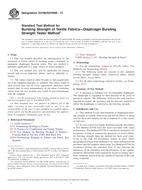We need your consent to use the individual data so that you can see information about your interests, among other things. Click "OK" to give your consent.
ASTM D3786/D3786M-13
Standard Test Method for Bursting Strength of Textile Fabrics´Diaphragm Bursting Strength Tester Method
STANDARD published on 1.1.2013
The information about the standard:
Designation standards: ASTM D3786/D3786M-13
Note: WITHDRAWN
Publication date standards: 1.1.2013
SKU: NS-24874
The number of pages: 4
Approximate weight : 12 g (0.03 lbs)
Country: American technical standard
Category: Technical standards ASTM
The category - similar standards:
Annotation of standard text ASTM D3786/D3786M-13 :
Keywords:
diaphragm bursting pressure, knitted fabric, non woven fabric, ICS Number Code 59.080.30 (Textile fabrics)
Additional information
| Significance and Use | ||||||||||
|
5.1 This method for the determination of diaphragm bursting strength of knitted, nonwoven and woven fabrics is being used by the textile industry for the evaluation of a wide variety of end uses. 5.2 In cases where test results obtained using the procedures in Test Method D3786 have not been correlated with actual performance, Test Method D3786 is considered satisfactory for acceptance testing of commercial shipments of textile fabrics for bursting strength since the method has been used extensively in the trade for acceptance testing. In cases where disagreement arising from differences in values reported by the purchaser and the supplier when using Test Method D3786 for acceptance testing, the statistical bias, if any, between the laboratory of the purchaser and the laboratory of the supplier should be determined with comparison based on testing specimens randomly drawn from one sample of material of the type being evaluated. 1.1 This test method describes the
measurement of the resistance of textile fabrics to bursting using
a hydraulic or pneumatic diaphragm bursting tester. This test
method is generally applicable to a wide variety of textile
products.
1.2 This test method may also be applicable for stretch woven and woven industrial fabrics such as inflatable restraints. 1.3 The values stated in either SI units or inch-pound units are to be regarded separately as standard. The values stated in each system may not be exact equivalents; therefore, each system shall be used independently of the other. Combining values from the two systems may result in non-conformance with the standard. 1.4 This standard does not
purport to address all of the safety concerns, if any, associated
with its use. It is the responsibility of the user of this standard
to establish appropriate safety and health practices and determine
the applicability of regulatory limitations prior to use.
|
||||||||||
| 2. Referenced Documents | ||||||||||
|
Similar standards:
Historical
1.7.2013
Historical
15.2.2014
Historical
1.1.2010
Historical
1.1.2014
Historical
1.5.2013
Historical
1.7.2012
We recommend:
Technical standards updating
Do you want to make sure you use only the valid technical standards?
We can offer you a solution which will provide you a monthly overview concerning the updating of standards which you use.
Would you like to know more? Look at this page.



 ASTM D5446-08(2013)..
ASTM D5446-08(2013).. ASTM D5587-14
ASTM D5587-14 ASTM D579/D579M-10..
ASTM D579/D579M-10.. ASTM D6140-00(2014)..
ASTM D6140-00(2014).. ASTM D6413/D6413M-13..
ASTM D6413/D6413M-13.. ASTM D6476-12
ASTM D6476-12
 Cookies
Cookies
